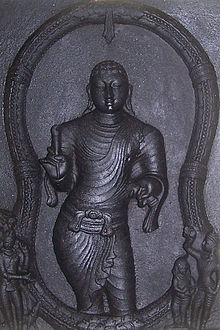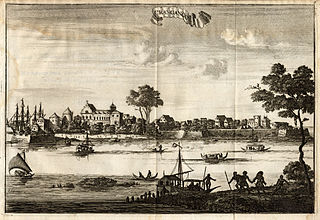
Kodungallur is a historically significant town situated on the banks of river Periyar on the Malabar Coast in Thrissur district of Kerala, India. It is 29 kilometres (18 mi) north of Kochi (Cochin) by National Highway 66 and 38 km (24 mi) from Thrissur. Kodungallur, being a port city at the northern end of the Kerala lagoons, was a strategic entry point for the naval fleets to the extensive Kerala backwaters.

The Chera dynasty, was a Sangam age Tamil dynasty who unified various regions of the western coast and western ghats in southern India to form the early Chera empire. The dynasty, known as one of the Three Crowned Kings of Tamilakam alongside the Chola and Pandya, has been documented as early as the 4th to 3rd centuries BCE. Their governance extended over diverse territories until the 12th century CE.
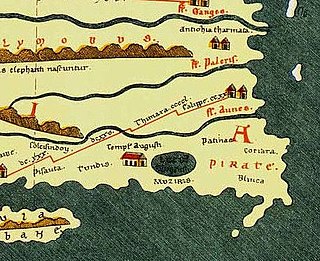
Muchiri, commonly anglicized as Muziris was an ancient harbour and an urban centre on the Malabar Coast. Muziris found mention in the Periplus of the Erythraean Sea, the bardic Tamil poems and a number of classical sources. It was the major ancient port city of Cheras. Core of the city situated in the present day North Paravoor area. The exact location of Muziris has been a matter of dispute among historians and archaeologists. However, excavations since 2004 at Pattanam, near North Paravur and Kodungallur, have led some experts to suggesting the hypothesis that the city was located just there. It was an important trading port for Christian and Muslim merchants arriving from other countries.
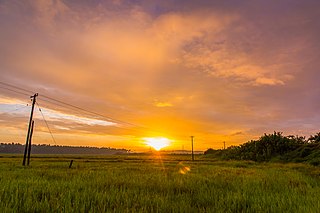
Thrissur, anglicised as Trichur, is one of the 14 districts in the Indian state of Kerala. It is situated in the central region of the state. Spanning an area of about 3,032 km2 (1,171 sq mi), the district is home to over 9% of Kerala's population.

Mushika dynasty, also spelled Mushaka, was a minor dynastic power that held sway over the region in and around Mount Ezhi (Ezhimala) in present-day North Malabar, Kerala, India. The country of the Mushikas, ruled by an ancient lineage of the Hehaya clan of the same name, appears in early historic (pre-Pallava) south India and it is believed that Mushika dynasty has their descents from Heheya Kingdom. Early Tamil poems contain several references to the exploits of Nannan of Ezhimalai. Nannan was known as a great enemy of the pre-Pallava Chera chieftains. The clan also had matrimonial alliances with the Chera, Pandya and Chola chieftains. The Kolathunadu (Kannur) Kingdom, which was the descendant of Mushika dynasty, at the peak of its power, reportedly extended from Netravati River (Mangalore) in the north to Korapuzha (Kozhikode) in the south with Arabian Sea on the west and Kodagu hills on the eastern boundary, also including the isolated islands of Lakshadweep in the Arabian Sea.

Pattanam is a village located in the Ernakulam District in the southern Indian state of Kerala. It is located 2 km north of North Paravur, 6 km and East of Chendamangalam 25 km north of Kochi (Cochin).

Kulasekhara, one of the twelve Vaishnavite alvars, was a bhakti theologian and devotional poet from medieval south India. The Trikkulasekharapuram Temple in Kodungallur is considered as the Alvar's birth place, located in modern-day Kerala region. He was the author of Perumal Tirumoli in Tamil and "Mukundamala" in Sanskrit. The Perumal Tirumoli, whose second decade is known as "Tetrarum Tiral", is compiled as a part of Nalayira Divya Prabandham. The Trikkulasekharapuram Temple in Kodungallur is considered as the Alvar's birth place.

Vellalore is a panchayat town in Coimbatore district in the Indian state of Tamil Nadu. It is a southern suburb of the city. It is at 12 km east of Townhall, the centre of the city Coimbatore. It is situated on the southern bank of Noyyal river.
Jainism, one of the three most ancient Indian religious traditions still in existence, has very small presence (0.01%) in Kerala, in south India. According to the 2011 India Census, Kerala only has around 4500 Jains, most of them in the city of Cochin, Calicut and in Wayanad district.

Wadakkancherry is a major town in Thrissur, Kerala. Up until 1860, this area was part of Chelakkara Taluk. Now, it is the headquarters of Talappilly Taluk. Wadakkanchery obtained municipality status from the government by merging with the Mundathikode panchayath and it is the only town in Thrissur District to be raised as municipality recently. There are two places with similarly pronounced names: Wadakanchery and Vadakkenchery.

Rama Rajasekhara was a Chera Perumal ruler of medieval Kerala, south India. Rajasekhara is usually identified by historians with Cheraman Perumal Nayanar, the venerated Shaiva (Nayanar) poet-musician of the Bhakti tradition.
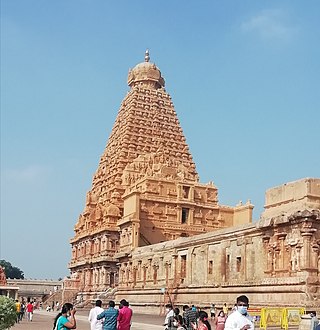
Brihadishvara Temple, called Rajarajesvaram by its builder, and known locally as Thanjai Periya Kovil and Peruvudaiyar Kovil, is a Shaivite Hindu temple built in a Chola architectural style located on the south bank of the Cauvery river in Thanjavur, Tamil Nadu, India. It is one of the largest Hindu temples and an exemplar of Tamil architecture. It is also called Dakshina Meru. Built by Chola emperor Rajaraja I between 1003 and 1010 CE, the temple is a part of the UNESCO World Heritage Site known as the "Great Living Chola Temples", along with the Chola-era Gangaikonda Cholapuram temple and Airavatesvara temple, which are about 70 kilometres (43 mi) and 40 kilometres (25 mi) to its northeast respectively.
Kandarodai is a small hamlet and archaeological site of Chunnakam town, a suburb in Jaffna District, Sri Lanka. The notable ancient Buddhist monastery referred to as Kadurugoda Vihara is situated in Kandarodai.
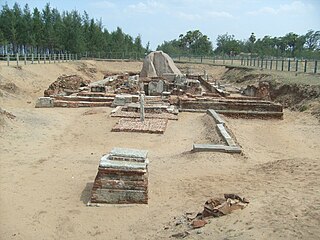
The Murugan Temple at Saluvankuppam, Tamil Nadu, India, is a shrine dedicated to Tamil Hindu deity Murugan. Archaeologists believe that the shrine, unearthed in 2005, consists of two layers: a brick temple constructed during the Sangam period and a granite Pallava temple dating from the 8th century CE and constructed on top of the brick shrine making it the oldest temple in India. The Archaeological Survey of India (ASI) team which conducted the excavation believe that brick temple could be the oldest of its kind to be discovered in Tamil Nadu.

Sthanu Ravi Varma, known as the Kulasekhara, was the Chera Perumal ruler of Kerala in southern India from 844/45 to 870/71 AD. He is the earliest Chera Perumal ruler known to scholars.

Cheraman Perumal Nayanar was a bhakti poet-musician and religious teacher of Tamil Shaiva tradition in medieval south India. The Cheraman Perumal's friendship with Sundarar, one of the 'Three Nayanars', is celebrated in the bhakti tradition. The legend of the Cheraman Perumal is narrated in the hagiographic Periyapuranam, composed by Chekkizhar, a courtier of Chola Kulottunga II, in mid-12th century AD. The collection is based on an earlier work by Nambiyandar Nambi. Thiruvanchikulam Siva Temple in Kodungallur is associated with the Perumal and Chundaramurtti Nayanar.
This is a list of ancient Buddhist sites, relics, traditions and places from the Indian state of Kerala. Even though Kerala does not have any major presence of Buddhists in modern times, many historians recognize a Buddhist heritage that seem to have existed until the 10th century CE along with a widespread Sramana tradition of co-existence between Buddhism, Jainism and ancient Dravidian folk religion.

Cheraman Perumal dynasty, also known as the Perumal dynasty of Kerala, or Chera Perumals of Makotai, were a ruling dynasty in present-day Kerala, South India. Mahodayapuram, or Makotai, the seat of the Cheraman Perumals, is identified with present-day Kodungallur in central Kerala. Initially, their influence appeared limited to the area between present-day Quilon and Quilandy, but later extended to up to Chandragiri river in north Kerala and to Nagercoil in the south.

Kongu Chera dynasty, or Cheras of Kongu or Karur, or simply as the Chera dynasty, were a medieval royal lineage in south India, initially ruling over western Tamil Nadu and central Kerala. The headquarters of the Kongu Cheras was located at Karur in central Tamil Nadu. The Chera rulers of Kongu were subordinate to or conquered by Pallava, Pandya and Chola rulers are also said to have overrun the Kongu Chera country.
Archaeology in Tamil Nadu is mainly done under the supervision of Archaeological Survey of India and Tamil Nadu State Department of Archaeology. As of 2023, excavations have been done at 40 sites and 36 reports have been issued.

